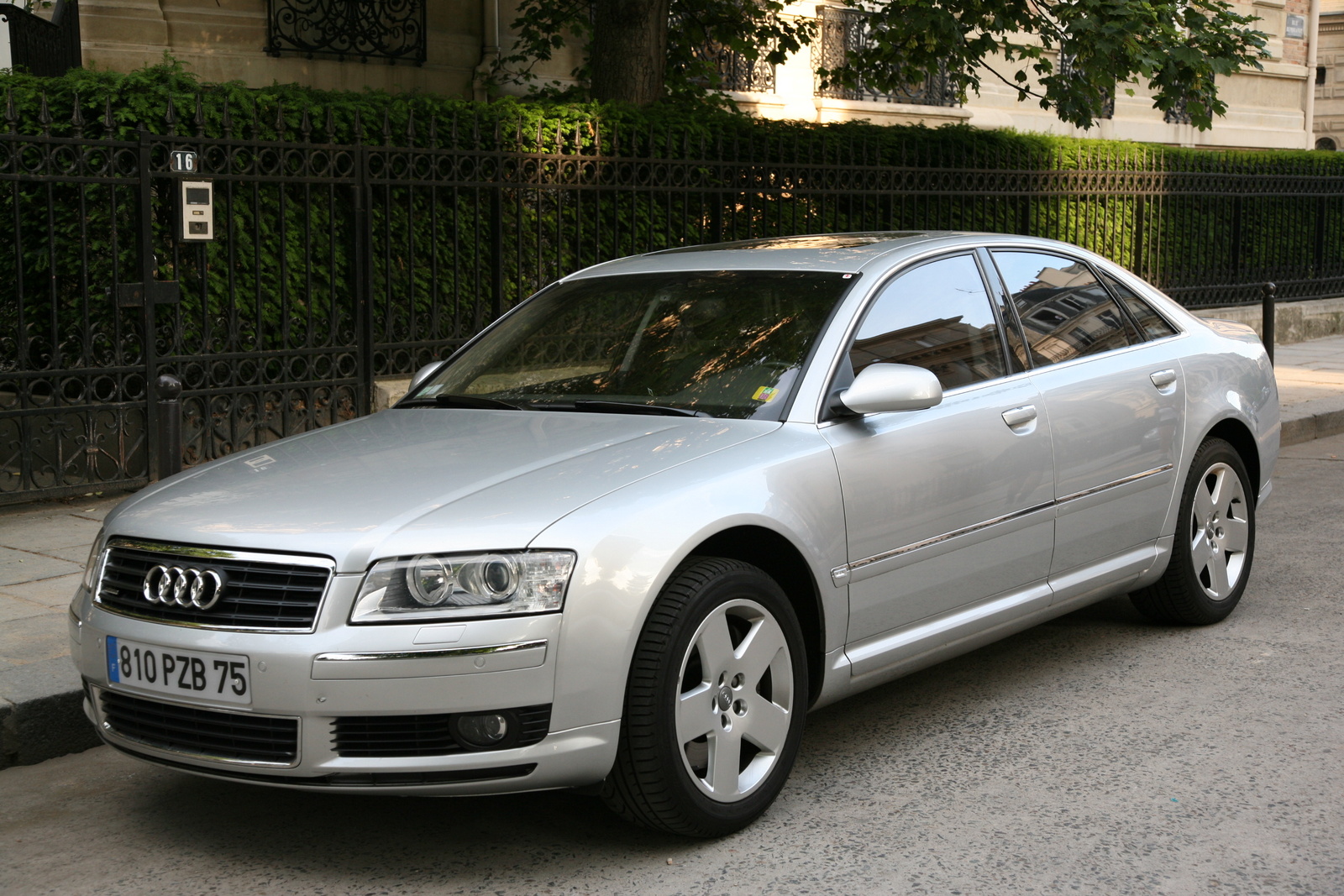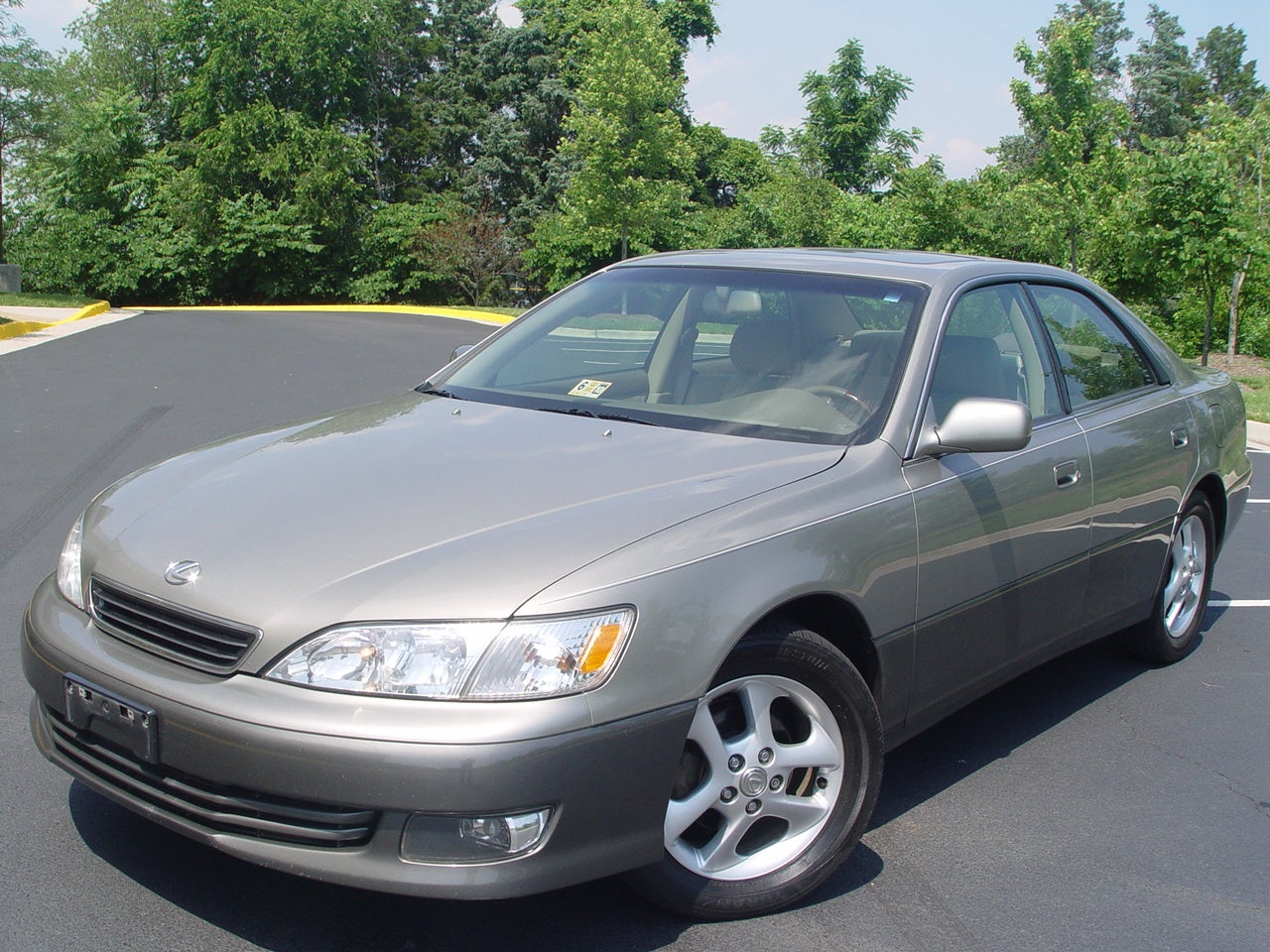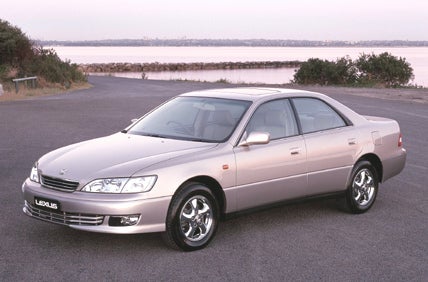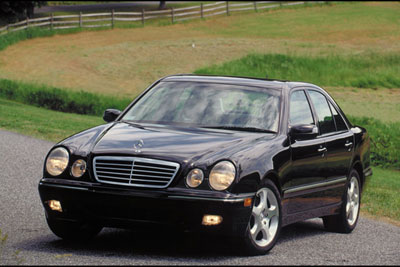
With the E-Class entrenched in North America as a luxury
machine, it can be a little disconcerting to see that it is used as a taxicab
in much of the rest of the world. Mercedes' reputation wasn't built on plush
fittings and heavily chromed decoration, it was earned by cars that could
survive for decades pounding over dirt roads or broken pavement, or forming a
line drawn by rival militias lobbing grenades at each other. Mercedes cars are
tough, and that's what made them worth extra money even when they didn't offer
overt power or luxury.
While the E-Class' ancestry stretches back to the 19th
century and the beginning of Mercedes, the lineage becomes more distinct after
World War II when the prewar 170 sedan reentered production. The stout 170 had
been Mercedes' most popular model before the war, but the design dated all the
way back to 1936; and in 1946 its upright stance, separate fenders and running
boards and chassis were archaic. Fortunately for Mercedes in the immediate
post-war years, the few buyers there were in Europe weren't in any position to
be picky.
It's the 170's replacement, the first "modern"
Mercedes, which started the company on the path toward today's E-Class.
The Ponton (W120: 1953-1962)
The 1953 Mercedes 180 was the company's
announcement that it could build and compete in the world's contemporary
automotive market. With bulbous fenders integrated into its body design, the
W120 (its name inside Mercedes) was the company's first car to feature the "envelope"
styling that was the defining element of modern post-war design (the '49 Ford
helped establish the style). Those bulbous fenders also gave rise to the 180's
nickname: the "Pontoon" or, the German spelling, "Ponton"
Mercedes.
Also unlike previous Mercedes, the W120's body was actually
part of the car's structure, though it wasn't quite yet what would be
considered a "unibody" today. The front of the car consisted of a
separate subframe to which was bolted a double-wishbone independent front
suspension. The rear suspension used the wicked swing arm system with which
Mercedes was infatuated at the time.
The big advantage of the Ponton body style was that it was
exceptionally large inside for a car of only modest size on the outside (the
original 1953 180's 104.3-inch wheelbase and 176-inch overall length are nearly
identical to those of a 2003 Honda Civic). But what held that first 180 back
was the engine; a 1.8-liter four scavenged from the old 170 model with an
L-head, a 6.5-to-1 compression ratio and an output of just 52 horsepower.
Stirring the column-shifted four-speed manual transmission for all it was
worth, the 2,700-pound 180 had performance between slow and agonizingly slow.
And if agonizingly slow wasn't slow enough, in 1954 buyers could get
the 180D, powered by a 1.8-liter diesel four rated at only 40 horsepower.
W120s may have been slow, but they were wonderfully rugged.
European and developing countries would soon adopt the car (particularly the
diesel) as their taxicab of choice. Even today, a full 50 years after the W120
was introduced, they're still used as taxis in countries like Syria.
For 1955, Mercedes put the 190SL roadster into
production, basing most of its chassis and running gear on the W120. But the
190SL also introduced a new overhead cam, 1.9-liter four. This thoroughly
modern (by 1950s standards) power plant made a credible 120 horsepower while
breathing through two carburetors in the roadster, and it was inevitable that
it would find its way into the sedan. In 1956, it made that migration and
the 190 sedan was born with 75 horsepower available through its single
carburetor 1.9-liter four. In '57 the 180 also got a version of the new engine,
this time rated at 65 horsepower. Then, in October 1958, a dieselized
version of the 190 power plant was introduced in the new 190D, making 50
horsepower. Finally for the 1959 model year, a 190b model was
introduced that got 90 horsepower from its four.
Outwardly, there were few differences among the W120s that
accounted for an astounding 62 percent of Mercedes' production during its run.
Their intrinsic solidity made them so important in building Mercedes'
reputation for quality, not their rakish lack of style. By the beginning of the
1960s, the W120 was exhausted.
The Fintail (W110: 1961-1968)
Mercedes usually didn't lower itself to following automotive
fashion trends. But in 1961, it introduced a new midsize model with…tail
fins. Just like a Plymouth or Cadillac. It was also virtually indistinguishable
(except for size) from its larger Mercedes sedan brother (which was almost six
inches longer).
It's those small tail fins that gave the new W110 sedans
their nickname "Fintail." But the fins aren't the major contribution
of the W110 to the E-Class legacy. The really important developments included
on the W110 were front disc brakes, an automatic transmission and a
six-cylinder engine.
Other than the fins, the W110 differed from the Ponton car
it replaced by being just over nine inches longer and over two inches wider
overall. The hood was shorter than the Ponton's, however, and that left much of
the car's extra length in the tail where it resulted in an enormous trunk.
Inside, the W110 was exceptionally roomy for its still modest size, and the
dashboard notably featured a tall pod directly in front of the driver outfitted
with thermometer-style instrumentation (imagine a speedometer that fills up
like a fund-raising drive's poster as the car's speed increases).
Under the skin, the W110 carried over the basic suspension
and chassis design of the old W120. The front end was still supported by double
wishbones, while the rear suspension still consisted of swing axles now blessed
with a horizontal spring to help compensate for differences in side-to-side
weight distribution.
The W110 hit the market in '61 as 190 and 190D models (sold
alongside some versions of the W120 through '62), carrying over the
gasoline-fired 80-horsepower, 1.9-liter four and the 2.0-liter diesel four. In
'62 an automatic transmission (a semiautomatic four-speed unit) was offered on
the 190 for the first time.
For the 1965 model year, the 190's engine grew to
2.0 liters and output snaked up to a full 95 horsepower and the name changed to
200 (the diesel, which already had a 2.0-liter engine, became the 200D). But
the big (literally) news was the availability of six-cylinder power for the
first time in a midsize Mercedes with the introduction of the 105-horsepower
230. The 2.3-liter OHC six used in the 230 was familiar from the larger 230S
sedan, and slightly detuned for use in the smaller W110. Besides the extra
power, the 230 distinguished itself with new headlight assemblies that combined
the turn signals and headlights into one unit capping the front fenders.
Four-cylinder 200 models continued to carry separate round headlights.
Like the Ponton model before it, the small Fintail (as
opposed to the larger "S" Fintail) was easily the most popular car in
the Mercedes line, accounting for 59 percent of total production. And the
ruggedness and economy of the diesel version made it a hugely popular cab
around the world. But by 1968, after 622,453 Fintails, it was time for a new
car.
The Stroke-8 (W114/W115: 1968-1976)
With its antiseptically clean and simple styling, the 1968 W114/W115
looks contemporary and elegant even in the 21st century. And with the
replacement of that archaic swing axle rear suspension with a new trailing arm,
fully independent system, it finally had a suspension worthy of a Mercedes.
The W114/W115 (the W114 was a six-cylinder model, the W115
had fours) was a wholly new midsize Mercedes expanded to include models with
four-, five- and six-cylinder engines. In fact, there were times during the
model's life that up to 15 separate models existed inside the midsize Mercedes
family, including a two-door variant. The "Stroke-8" name arose when
it was necessary to distinguish the new car from the old Fintail that continued
in production during 1968 and carried the same model names. During '68, a 200D
was likely a Fintail, while a 200D/8 was definitely a W115. Even after the
Fintail was gone, that Stroke-8 heritage persisted in the informal world of
nicknames.
A lower hood line led to a wider, lower grille shell on the
Stroke-8 models, while thinner pillars and a two-inch longer wheelbase than the
Fintail gave the cabin an open, airy feel. But despite the wheelbase stretch,
the Stroke-8's 184.5-inch overall length was actually two inches shorter than
the car it replaced. Further, thanks to a robust unibody structure and new
safety equipment like a padded dash, the Stroke-8 weighed in about 300 pounds
heavier than its predecessor.
The Stroke-8's chassis was truly new and the engines
initially powering it were familiar but, at least in North America, not
identical. The base four over here grew to 2.2 liters and output swelled to 116
horsepower and, naturally, the car was named the 220. The 230 continued with
the 2.3-liter six, but output had by now grown to 135 horsepower. A new
2.5-liter version of the six appeared in (there's a pattern here) a new 250
sedan as well and that engine produced 146 horsepower.
The coupe arrived during the 1970 model year as
the 250C ("C" for, you guessed it, coupe) sitting on the same
wheelbase as the sedan, but about two inches lower in overall height. And while
it was called the 250C, it didn't actually carry the 2.5-liter six. Instead it
had a 2.8-liter version of the six aboard making 157 horsepower. In 1971,
the 250 sedan was blessed with the 2.8-liter engine.
Both the coupe and sedan were slightly redesigned for 1973 getting
an updated front end, new fluted tail lamps and bigger bumpers to meet U.S.
Federal regulations. More significant was a new 2.8-liter, DOHC straight six
under the hoods of the newly named 280 and 280C. With emissions regulations
getting tougher, engine outputs were dropping everywhere, so the new engine's
130-horsepower output was actually quite respectable. Also, for the first time,
an automatic transmission was standard with the six-cylinder Stroke-8s.
In 1974, the four-cylinder engine was upgraded to 2.3
liters and 95 horsepower so the car (then Mercedes' cheapest for sale in
America) was renamed the 230. A new 2.4-liter diesel four was also available in
the 240D rated at 62 horsepower. The big diesel news came in'75 however,
when Mercedes grafted another cylinder to the new diesel four to create a
3.0-liter straight five diesel making 77 horsepower — at the time, the most
power available in a diesel passenger car.
On the gasoline-fueled side of the equation, 1975 brought
with it the first use of catalytic converters. That clog in the exhaust system
only robbed the 230's four of two horsepower (down to 93), but the 280's six
retreated a full 10 horsepower to 120.
The Stroke-8 was wildly popular, with Mercedes building
1,833,442 of them before ending production during 1976. That's a stunning 77
percent of all Mercedes passenger-car production during that time. It would be
a tough act to follow.
The Wedge (W123: 1977-1985)
With a slight rake to its stance, the new W123 (on sale in
Europe during 1976 and a 1977model in America) was undeniably a Mercedes
of the 1970s. With a flattened grille, horizontally oriented headlamps and
sculptured sides, it looked, more or less, like a scaled-down version of the era's
450SEL.
Under the new skin were some significant advances in safety
(moving the fuel tank over the rear axle where it was better protected in a
collision, for instance), but the biggest change came in the engine bay of the
six-cylinder model where fuel injection appeared for the first time on the
smaller Mercedes. Accordingly, the letter "E" for
"einspritz" (German for "injection") appeared as part of
this model's name, 280E.
While the W123's wheelbase grew to a full 110 inches (up
from the Stroke-8's 108.3), overall length was down in the U.S. thanks to an
improved bumper system (European W123s were actually slightly longer than
European Stroke-8s). That again meant even more room inside the cabin that,
like the exterior, was styled along the lines of the big S-Class.
The last midsize Mercedes powered by a four-cylinder gas
engine to be sold in the U.S. appeared as the 230 sedan in '77. Breathing
through a single-barrel carburetor, the 2.3-liter four in the 230 could only
muster 86 horsepower and came standard with a manual transmission. From '78 on,
the cheapest W123 would be the diesel 240D, whose four-cylinder engine
clattered out 62 horsepower. The five-cylinder 300D also continued to be
offered with a power rating of 77 horsepower.
It was the fuel injection atop the 280E's 2.8-liter, DOHC
straight six that radically improved the drivability of the new W123. With 142
horsepower available, the '77 280E sedan was no high-velocity rocket ship, but
the engine was flexible and friendly in its power delivery.
The 1978 model year brought forth new 280CE and
300CD coupes, and in '79, a new 300TD station wagon arrived. All were
built on the same 110-inch wheelbase as the sedan, though the coupes were about
1.5 inches lower overall. The wagon offered a third-row seat as an option. In
the late '70s, mired as the era was in serial fuel crises, the economical
diesel was appreciated by most buyers.
Innovations that would become regular equipment on future
Mercedes models appeared during the W123's life. The 1980model year
brought a four-speed fully automatic gearbox, and antilock brakes were
available for the first time. In '81, a driver-side front airbag made its
first appearance.
Surprisingly, Mercedes eliminated the gasoline-fueled W123s
from the American market after 1981 and instead installed the 120-horsepower
turbodiesel five from the S-Class in the 300D. And that's how the W123 played
out its days in America.
Mercedes built a total of 2,375,440 W123s, including 199,517
wagons.
The E Name Arrives (W124): 1986-1995
The most important thing about the W124 is that it was
conceived and designed by Mercedes after the company's introduction of the
smaller 190-Series (what would eventually become the C-Class) for 1984. That,
for the first time, meant the company was selling passenger cars smaller than
the E's progenitors — the midsize Mercedes was now actually in the middle of
the range.
Everything about the new Mercedes W124 was new and
everything about it looked new — more 1990s than mid-1980s. The structure was
completely revised and, through the use of high-strength steel and other
construction methods, was significantly stiffer and lighter. The front
suspension still utilized double wishbones but incorporated anti-dive
technology; and the rear suspension was now a multilink system, which rode
better and improved wheel location throughout its travel. The front grille
sloped back for better aerodynamics and there was but a single windshield wiper
that, using an eccentric cam, was able to clear that big piece of steeply raked
glass all by itself. Even the engines were new. In the history of Mercedes
sedans, there's never been one more completely revised than the 1986 300E
and 300D.
Slightly narrower than the W123, but sitting on a somewhat
longer wheelbase, the W124 weighed in about 200 pounds lighter than its
forebear. Power for the gasoline-fired 300E came from a new 3.0-liter, SOHC,
12-valve straight six making 177 horsepower, while a new 148-horsepower,
3.0-liter turbodiesel straight six motivated the 300D. Both models came with a
four-speed automatic as the standard transmission.
Because the 190 attracted bargain shoppers, the W124 took a
notable step up in price and standard luxuries. A driver-side front airbag,
antilock brakes, central power locking, power windows, headlamp washers, an
alarm system and dozens of other items, which were once options on this class
of Mercedes, were now standard.
For 1987, a 260E sedan joined the W124 model mix in the
U.S., powered by a 2.6-liter version of the 300E's straight six rated at 158
horsepower. Also new that year was a station wagon that came only in 300TD
turbodiesel form.
The 1988 model lineup included a new, crisply
styled 300CE coupe, and a five-speed manual transmission was now offered on
260E and 300E. Considering that just a few years earlier diesels had made up
over three-quarters of all Mercedes sold in the United States, the
disappearance of diesels from Mercedes' 1988 lineup may have been a surprise.
But increasingly severe particulate emissions standards left the company little
choice. This also meant that Mercedes was finally selling a gasoline-powered
wagon here as a 300TE.
The 1989 model range was virtually unchanged
except that the five-speed manual transmission (few of which were ordered
anyhow) was gone from the lineup again and a passenger-side front airbag was a
new option.
A diesel returned to the 1990 W124 line with the
introduction of an all-new 2.5-liter turbocharged inline five aboard the
awkwardly named 300D 2.5. The 260E was also inelegantly renamed the 300E 2.6
for no apparent reason. By stealing the DOHC, 24-valve cylinder head from that
year's new 300SL roadster, the 300CE's 3.0-liter straight six now made a
healthy 217 horsepower. Beyond that, if you wanted Mercedes' 4Matic
all-wheel-drive system on your 300E sedan or 300TE wagon, you could get it.
For fans of traction control, 1991 was a big year
as Mercedes' ASR system became optional on the 300E, 300TE and 300CE.
Much bigger news came with the 1992 models and the
introduction of V8 power to the midsize Mercedes. The new, mainstream 400E
sedan had the 268-horsepower, 4.2-liter, DOHC V8 from the larger S-Class sedan
under its hood. Meanwhile, the glorious limited-production Porsche-built 500E
was also introduced with the 500SL's 5.0-liter, DOHC V8 between its specially
flared fenders. With 322 horsepower on board, the 500E was easily the most
powerful midsize Mercedes ever and the quickest sedan of any size the company
had ever built.
Dual front airbags were standard across Mercedes' 1993 line
and new engines were installed in the W124. The 300E 2.6 became the 300E 2.8 as
the engine grew to 2.8 liters and now wore a DOHC head with four valves per
cylinder. And all 300E "3.0" models (except the wagon and 4Matic
sedan) had their 3.0-liter engines upgraded. Now at 3.2 liters and sporting
DOHC, 24-valve architecture, this engine produced 217 horsepower. This year
also saw the debut of the 300CE Cabriolet.
Finally for 1994, the E-Class officially came to be, as
Mercedes reengineered its naming system by putting the "E" before the
number and rationalizing the numbers in line with displacement. So the
returning lineup consisted of E320 sedan, wagon and coupe, E420 sedan and E500
sedan. We guess "E" no longer stood for "einspritz." To
celebrate their new name, the W124s got new grilles, headlights and taillights
for '94. At midyear, an E300D diesel arrived with a normally aspirated
3.0-liter straight six making 134 horsepower. Also, the 4Matic versions were
dropped this year.
With a new E-Class due for '96, the only substantial change
to the '95 line was the elimination of the limited-production E500.
After 2,212,025 W124s, Mercedes was ready for a new E-Class.
The Four-Eyed E (W210): 1996-2002
With four elliptical headlamps, the 1996 E-Class
(W210) set the styling trend for Mercedes models into the 21st century.
Underneath the dramatic new aerodynamic skin, the wheelbase grew 1.3 inches
over the W124's and overall length was up 2.2 inches. The engineering itself
was rather familiar. There were still double wishbones doing the suspension
work up front, and a multilink system holding up the rear.
For '96, the new W210 E-Class models offered in the U.S. were
the E320 with the 3.2-liter, DOHC six from the outgoing W124 making 217
horsepower, and the E300D with the carryover 3.0-liter diesel six. The W124
E320 coupe and convertible carried over for the time being.
In the middle of the '96 model year, the E420 sedan
reappeared with the 4.2-liter V8 (making 275 horsepower) hooked up to a
five-speed automatic transmission.
The 1997 model year saw the introduction of a new
driver-adaptive five-speed automatic for the E320 and E300D. Additionally,
Mercedes added a sport package to the options list for the E420 — included
within it were 17-inch wheels and Z-rated tires, foglights and various cosmetic
touches. All models got a smart sensor that could detect the presence of a
front passenger and decide whether or not to deploy the airbag in a crash.
Major changes to the W210 for '98 began with a new
3.2-liter, SOHC, three-valve V6 replacing the former straight six in the E320,
the station wagon body returning as an E320 and the E300D gaining a
turbocharger and intercooler. The boosted diesel was impressive with a
30-percent increase in horsepower and a massive 57-percent increase in torque.
Beyond all that, the 4Matic all-wheel-drive system was back as an option.
A new side curtain airbag system came with the 1999 E-Class,
but the more enticing development was the new AMG-engineered E55 sport sedan.
Using a hand-assembled 5.4-liter version of the SOHC, three-valve V8, the E55
was engorged with 349 horsepower. It was fast and gorgeous hunkered over its
18-inch AMG wheels, and it was the most expensive E-Class ever. Also this year,
the E420 became the E430, as its V8 was a new 4.3-liter mill, though output was
unchanged.
The diesel disappeared again as the 2000 model
year started and the "Touch Shift" system (that added a manual-shifting
scheme to the five-speed automatic gearbox) debuted. A revised front end and
interior appeared in '02 as well.
With a new E on the way, 2001 and 2002 were
relatively quiet years for the car. But you could get a new sport package for
the E320 that included lower body cladding and larger wheels and tires.
The Current E (W211): 2003
Building on themes established by its immediate predecessor,
the current E-Class arrived in the U.S. for 2003 more voluptuous than
the W210, proudly displaying Mercedes' new styling direction. The E320 received
the now familiar 3.2-liter, SOHC V6 making 221 horsepower, while the new E500's
5.0-liter, SOHC, 24-valve V8 knocks out 302 horsepower. It is also the first
E-Class since 1985 to have two windshield wipers. Among the interesting new
features on the W210 generation are electronically controlled brakes, an
adaptive suspension (standard on the E500, optional on the E320) that
continually adjusts spring and damper rates for the benefit of ride quality and
handling, four-zone climate control and optional Drive Dynamic seats that alter
cushioning in response to cornering forces.
For 2004, a new station wagon comes, 4Matic is back and
the E55 sedan returns with a supercharger atop its 5.4-liter V8 to produce a
walloping 469 horsepower. That's nine times as much as that first Ponton 180 in
1953.













